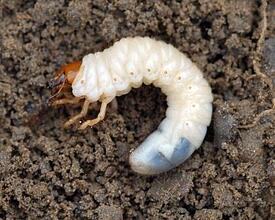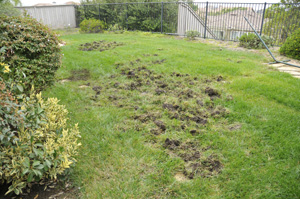The Signs of the Times, You Might Have White Grub Worms
June is the beginning of summer, it also signifies the arrival of the June bug – the beetles that buzz around and seemingly wreck into everything that crosses there path can leave a mess. But the beetles of June that aren’t so fortunate as some, can emerge later, potentially causing much bigger landscape challenges, more than than a few dead insects on the pavement.
They Lay There Eggs on Schedule
June bugs lay their eggs like clockwork that ultimately evolve into the white grub worm, which has been known to severely cause damage on lawns and ornamental flower beds in and across Bay Area Landscapes. The grubs live below the soils surface and mature at about a five inch depth below and usually thrive in well-nourished soil for about a period of one year prior to emerging from the ground as the June bug.
While a sparse group of white grubs can actually be beneficial to lawn, by providing necessary oxygen for aeration and moisture, they can wreck lawn areas and do harm to the root system of plants, especially in uncontrolled environments. They have a tendency to be most prevalent in the Months of July and August causing the most visual damage at this time of the year.
They like Lawns and Flowers
White grubs like to feed on cool season grasses, some of which include: perennial rye, Kentucky blue grass and tall fescue doing significant damage to their root system.

How To Identify the White Culprit
Grub worms can typically have a plump, white body with an orange or red head , grayish in color at the end of its body. Parts of their body are translucent in color and have a curled shape.
Also, be aware of Cut Worms and Army worms. Army worms are narrow and straight in length, a more dark color tone, and can be revealed with some yellow striping. Cut worms have a tendency to curl up like grubs but are tannish or green in color and may have obvious striping similar to Army worms. They can also be problematic causing root damage to your ornamental landscaping, flowers and turf areas.
The Damage Surfaces in Time
-
Landscapers with white grub damage may notice patches of dead grass. In addition, you may see raccoons and other wildlife like Skunk or other Pests digging up your lawn to get to the grubs. A high population of white grubs can result in grass that can be rolled up like carpeting. Furthermore, grass may feel bouncy as you walk across the lawn, according to the University of Davis. Healthy, densely growing grass with a moderate white grub population usually recovers from the damage.
How to Test for The White Culprit
-
Cut out 1 square foot of turf from the lawn with a masonry trowel to determine the severity of your white grub problem. If you find more than 10 grubs in the grass or dirt, consider options for treatment. You can control grubs through cultural practices if there are less than 10 in the turf patch. Landscapers may be tempted to treat grubs in the spring. However, late-summer pesticide applications are more effective because grubs have just hatched.
Cultural Treatment
-
Beetles look for moist soil to lay their eggs, so a dry lawn in the late summer is essential. Also, restricting water on your lawn will dry out the eggs. Gardeners can also check their thatch layer to see if it is more than 1/2 inch. If it is, it creates an optimal environment for grubs. If you decide to use pesticides, it is better to remove thick thatch so that the chemicals can be absorbed into the soil. Dethatch the lawn to remove grubs' environment and prepare the lawn for potential pesticide use.
Practical and Natural Treatments
For those choosing a more natural and sustainable landscaping approach , there are several options available. All of which are considered safe and effective. These include milky spore, neem oil, and nematodes – available at most garden centers.
- Milky spore is a disease that can effectively treat lawn grubs and is environmentally safe. Spores are applied to affected lawn areas, infecting lawn grubs as they feed. Once the grubs die and decompose, additional spores are released into the soil, which helps prevent further infestations.
- Neem oil is a botanical pesticide containing insecticidal properties. Neem oil works more as a repellant against Japanese beetles and lawn grubs – inhibiting egg laying, growth and feeding. Neem oil is mixed with water (as directed) and sprayed onto affected lawn areas.
- Nematodes are also used as natural grub treatment. These tiny, soil-dwelling worms release bacteria into the soil that infects and kills lawn grubs. Nematodes are available in liquid form or mixed with water and sprayed onto affected areas.
Chemical Treatment
-
Pesticides that contain imidacloprid or halofenozide should be applied between Aug. 1 and Sept. 15, according to local Universities. Apply the pesticide in the most severely damaged areas of the lawn. Water the pesticide after applying with 1/4 to 1/2 inch of water so that it sinks into the soil. You can also forgo watering if afternoon showers are expected. Reapply the pesticide as recommended on the label.
Once you know how to detect grub worms and how to get rid of grub worms, you’ll be better equipped to treat the problem more effectively.
A Few Grub Worms are tolerable in Bay Area Landscaping
It’s normal for grub worms to present themselves in bay area landscaping, especially those in favorable conditions, but don’t panic. In the summer months, it’s easy to be overly concerned about grub worm damage; although in many parts of Northern California they are not as active as one might think. A good practice is to begin treatments in July-August.
So please don’t worry; a few grub worms in the lawn aren’t worth losing sleep over. Just control them so they don’t get the best of your landscaping.
Challenged with Landscaping ? Leave it up to The Landscape Management Pro's! Call us at 408.275.1200 or click here
Experts in Landscape Management
FloraTerra is a Leading Landscape company , we design, install and maintain environmental friendly landscaping , providing a complete range of landscaping services, including landscape pest control for Residential Estates, Retail Shopping Centers, Mixed Use Development, Apartments and Multi-Residential Communities, Home Owners Associations, Condominiums and Commercial Office Landscaping.
San Jose | Santa Clara | San Francisco Bay Area | Palo Alto | Sunnyvale | Los Altos | Saratoga | Los Gatos
Get our FREE Landscaping Assessement by clicking below






